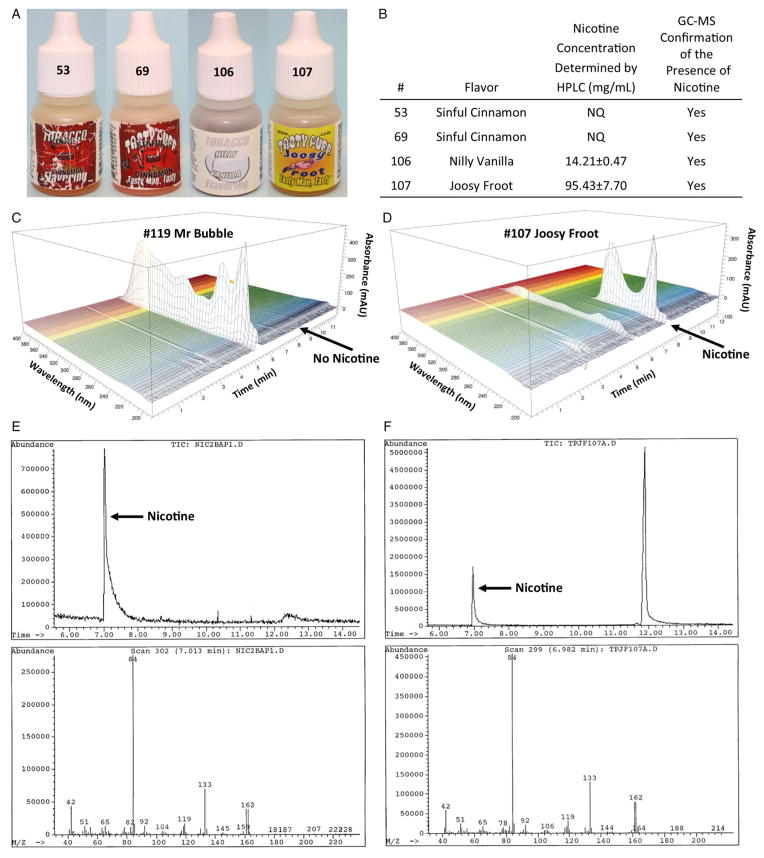Electronic cigarette (EC) users often create their own refill fluids by blending bottled nicotine/propylene glycol/glycerol mixtures with Do-it-Yourself (DIY) flavourings.1 Although a complete refill fluid usually contains nicotine, the flavouring solutions themselves are an additive and are presumed to be free of nicotine, which is a known addictive chemical and toxicant.2 To determine if DIY flavourings are nicotine free, we evaluated 30 products from one vendor, using high performance liquid chromatography (HPLC) (figure 1B–D), and confirmed the presence of nicotine via gas chromatography and mass spectrometry (GC-MS) (figure 1E, F). HPLC analysis was performed as previously described in detail.3 Nicotine was extracted from DIY flavorings4 and GC-MS analysis of the extracts was performed using a Hewlett-Packard 5890 Series II gas chromatograph equipped with a Restek Rtx-1MS, 30 m, 0.25 mm column and a Hewlett-Packard 5971A mass selective detector. Samples were analysed from 40°C to 250°C with a total run time of 32.75 min per sample. Of the 30 flavouring products evaluated via HPLC, 4 (figure 1A) had peaks with the retention time and shape characteristic of nicotine (figure 1C, D). GC-MS analysis confirmed the presence of nicotine in all four products (figure 1B, E, F). The limit of quantification for this method was 10 μg/mL. Nicotine was quantifiable in two bottles, which had concentrations of 14.2 and 95.4 mg/mL (figure 1B). Nicotine can be fatal to humans in doses of 500–1000 mg for adults5 and 10 mg for children.6 The total nicotine content in these two 5 mL bottles of DIY flavourings was 71 and 477 mg, doses that, if ingested, could be fatal to children and, possibly, to adults. Assuming a dilution factor of 1:10 (http://www.tastypuff.com/product/joosy-froot/), a solution mixed from the Joosy Froot flavour and propylene glycol alone would contain 9.5 mg/mL. These data demonstrate that DIY flavouring products, which are marketed for the purpose of flavour enhancement, may contain substantial amounts of nicotine. These DIY flavourings are named and described in terms that are attractive to children, have colourful attractive bottles and emit an aroma that may encourage ingestion. Some adult users of ECs are not addicted to nicotine and would avoid the use of these products if nicotine content were indicated on the label.
Figure 1.
Analysis of Do-it-Yourself (DIY) flavourings. (A) Bottles of DIY flavourings in which nicotine was positivity identified. Bottles are indicated by inventory numbers. Numbers 53 and 69 are duplicate bottles of Sinful Cinnamon, #106 is Nilly Vanilla and #107 is Joosy Froot. (B) Table summarising the high performance liquid chromatography (HPLC), and gas chromatography and mass spectrometry (GC-MS) results. The table indicates inventory number, flavour, quantified nicotine concentration (NQ=nicotine was not quantifiable but was qualitatively determined to be present) and GC-MS confirmation of nicotine. (C and D) Three-dimensional chromatograms of HPLC analysed flavourings, x axis=time (min), y axis=absorbance (mAU), z axis=wavelength (nm). (C) an example of a DIY flavour without nicotine (#119 Mr Bubble) and (D) an example of a DIY flavour (#107 Joosy Froot) that contains nicotine, as indicated by the ultraviolet absorption spectrum present at approximately 8 min. (E and F) GC-MS analyses of flavourings. GC data are shown in the two upper graphs, x axis=time (min), y axis=abundance (mAU) and MS data are in the lower graphs, x axis=m/z, y axis=abundance (mAU). (E) The nicotine standard and (F) an example of a flavouring (#107 Joosy Froot) found to be positive for nicotine.
The current finding of nicotine in DIY flavouring products that are expected to be nicotine free and our prior finding that a DIY bottle of nicotine (134.7 mg/mL) was unlabelled,3 are important public health problems. These products, which are presented to the consumer as ‘nicotine free’ (http://www.tastypuff.com/product/joosy-froot/), could lead to unwanted addiction, poisoning, or even death. The simplest solution to this problem would be, at minimum, to require that any products containing nicotine be clearly labelled with the term ‘nicotine’ and an accurate concentration. Consumers who wish to use 0% nicotine products could then avoid unwanted exposure and EC users could protect their children from accidental ingestion of nicotine. The demonstration of nicotine in presumably nicotine-free DIY flavouring solutions should be valuable information for regulatory agencies, physicians, EC users and poison control centres.
Acknowledgments
Funding This work was supported by the National Institutes of Health grant number R011DA036493 and a National Science Foundation Predoctoral Fellowship to BD.
Footnotes
Contributors BD planned the study, oversaw the HPLC and wrote the letter. AR performed and analysed the GC-MS data. MC performed and analysed the HPLC data. EN helped plan and design the GC-MS method, and assisted in editing the letter. PT designed the study, contributed to writing the letter and oversaw the project.
Competing interests None declared.
Provenance and peer review Not commissioned; externally peer reviewed.
References
- 1.e-cigarette-forum.com. A guide to making your own e-juice. [accessed 5 Mar 2015];E-Cigarette Forum. e-cigarette-forum.com. https://www.e-cigarette-forum.com/forum/threads/a-guide-to-making-your-own-e-juice.218802/
- 2.National Center for Chronic Disease Prevention and Health Promotion (US) Office on Smoking and Health. The health consequences of smoking—50 years of progress: a report of the surgeon general. Atlanta, GA: Centers for Disease Control and Prevention (US); 2014. [PubMed] [Google Scholar]
- 3.Davis B, Dang M, Kim J, et al. Nicotine concentrations in electronic cigarette refill and do-it-yourself fluids. Nicotine Tob Res. 2015;17:134–41. doi: 10.1093/ntr/ntu080. [DOI] [PMC free article] [PubMed] [Google Scholar]
- 4.Wong LS, Green HM, Feugate JE, et al. Effects of “second-hand” smoke on structure and function of fibroblasts, cells that are critical for tissue repair and remodeling. BMC Cell Biol. 2004;5:13. doi: 10.1186/1471-2121-5-13. [DOI] [PMC free article] [PubMed] [Google Scholar]
- 5.Mayer B. How much nicotine kills a human? Tracing back the generally accepted lethal dose to dubious self-experiments in the nineteenth century. Arch Toxicol. 2014;88:5–7. doi: 10.1007/s00204-013-1127-0. [DOI] [PMC free article] [PubMed] [Google Scholar]
- 6.inchem.org. [accessed 6 July 2015];Nicotine (PIM) https://www.inchem.org/documents/pims/chemical/nicotine.htm.



